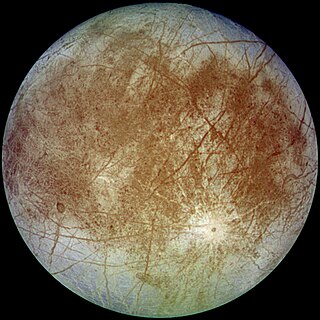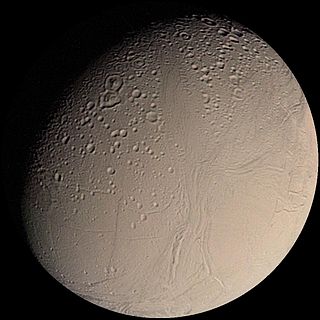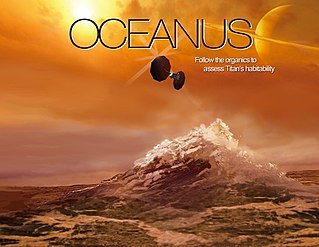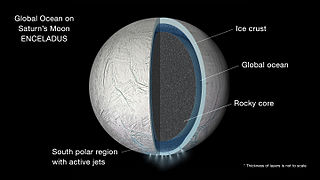
Astrobiology is a scientific field within the life and environmental sciences that studies the origins, early evolution, distribution, and future of life in the universe by investigating its deterministic conditions and contingent events. As a discipline, astrobiology is founded on the premise that life may exist beyond Earth.

Cassini–Huygens, commonly called Cassini, was a space-research mission by NASA, the European Space Agency (ESA), and the Italian Space Agency (ASI) to send a space probe to study the planet Saturn and its system, including its rings and natural satellites. The Flagship-class robotic spacecraft comprised both NASA's Cassini space probe and ESA's Huygens lander, which landed on Saturn's largest moon, Titan. Cassini was the fourth space probe to visit Saturn and the first to enter its orbit, where it stayed from 2004 to 2017. The two craft took their names from the astronomers Giovanni Cassini and Christiaan Huygens.

Tethys, or Saturn III, is a mid-sized moon of Saturn about 1,060 km (660 mi) across. It was discovered by G. D. Cassini in 1684 and is named after the titan Tethys of Greek mythology.

Enceladus is the sixth-largest moon of Saturn. It is about 500 kilometers in diameter, about a tenth of that of Saturn's largest moon, Titan. Enceladus is mostly covered by fresh, clean ice, making it one of the most reflective bodies of the Solar System. Consequently, its surface temperature at noon only reaches −198 °C, far colder than a light-absorbing body would be. Despite its small size, Enceladus has a wide range of surface features, ranging from old, heavily cratered regions to young, tectonically deformed terrain.
A biosignature is any substance – such as an element, isotope, or molecule – or phenomenon that provides scientific evidence of past or present life. Measurable attributes of life include its complex physical or chemical structures and its use of free energy and the production of biomass and wastes. A biosignature can provide evidence for living organisms outside the Earth and can be directly or indirectly detected by searching for their unique byproducts.
The New Frontiers program is a series of space exploration missions being conducted by NASA with the purpose of furthering the understanding of the Solar System. The program selects medium-class missions which can provide high science returns.

The exploration of Saturn has been solely performed by crewless probes. Three missions were flybys, which formed an extended foundation of knowledge about the system. The Cassini–Huygens spacecraft, launched in 1997, was in orbit from 2004 to 2017.
Jonathan I. Lunine is an American planetary scientist and physicist. Lunine teaches at Cornell University, where he is the David C. Duncan Professor in the Physical Sciences and Chair of the Department of Astronomy. Having published more than 380 research papers, Lunine is at the forefront of research into planet formation, evolution, and habitability. His work includes analysis of brown dwarfs, gas giants, and planetary satellites. Within the Solar System, bodies with potential organic chemistry and prebiotic conditions, particularly Saturn's moon Titan, have been the focus of Lunine's research.

The habitability of natural satellites describes the study of a moon's potential to provide habitats for life, though is not an indicator that it harbors it. Natural satellites are expected to outnumber planets by a large margin and the study is therefore important to astrobiology and the search for extraterrestrial life. There are, nevertheless, significant environmental variables specific to moons.

Titan Saturn System Mission (TSSM) was a joint NASA–ESA proposal for an exploration of Saturn and its moons Titan and Enceladus, where many complex phenomena were revealed by Cassini. TSSM was proposed to launch in 2020, get gravity assists from Earth and Venus, and arrive at the Saturn system in 2029. The 4-year prime mission would include a two-year Saturn tour, a 2-month Titan aero-sampling phase, and a 20-month Titan orbit phase.

A planetary-mass moon is a planetary-mass object that is also a natural satellite. They are large and ellipsoidal in shape. Two moons in the Solar System are larger than the planet Mercury : Ganymede and Titan, and seven are larger and more massive than the dwarf planets Pluto and Eris.

Enceladus Life Finder (ELF) is a proposed astrobiology mission concept for a NASA spacecraft intended to assess the habitability of the internal aquatic ocean of Enceladus, which is Saturn's sixth-largest moon and seemingly similar in chemical makeup to comets. The spaceprobe would orbit Saturn and fly through Enceladus's geyser-like plumes multiple times. It would be powered by energy supplied from solar panels on the spacecraft.
Journey to Enceladus and Titan (JET) is an astrobiology mission concept to assess the habitability potential of Enceladus and Titan, moons of Saturn.
Life Investigation For Enceladus (LIFE) was a proposed astrobiology mission concept that would capture icy particles from Saturn's moon Enceladus and return them to Earth, where they could be studied in detail for signs of life such as biomolecules.
Enceladus Explorer (EnEx) is a planned interplanetary orbiter and lander mission equipped with a subsurface maneuverable ice melting probe suitable to assess the existence of life on Saturn's moon Enceladus.

Oceanus is a NASA/JPL orbiter mission concept proposed in 2017 for the New Frontiers mission #4, but it was not selected for development. If selected at some future opportunity, Oceanus would travel to Saturn's moon Titan to assess its habitability. Studying Titan would help understand the early Earth and exoplanets which orbit other stars. The mission is named after Oceanus, the Greek god of oceans.

Explorer of Enceladus and Titan (E2T) is a space mission concept that would investigate the evolution and habitability of the Saturnian satellites Enceladus and Titan and is proposed by the European Space Agency in collaboration with NASA.

Enceladus Life Signatures and Habitability (ELSAH) is an astrobiology concept mission proposed in 2017 to NASA's New Frontiers program to send a spacecraft to Enceladus to search for biosignatures and assess its habitability. The Principal Investigator is Christopher P. McKay, an astrobiologist at NASA Ames Research Center, and the managing NASA center is Goddard Space Flight Center. No details of the mission have been made public, but observers speculate that it would be a plume-sampling orbiter mission.

The Ocean Worlds Exploration Program (OWEP) is a NASA program to explore ocean worlds in the outer Solar System that could possess subsurface oceans to assess their habitability and to seek biosignatures of simple extraterrestrial life.
The Enceladus Icy Jet Analyzer (ENIJA) is a time-of-flight mass spectrometer developed to search for prebiotic molecules like amino acids and biosignatures in the plumes of Saturn's moon Enceladus.
















